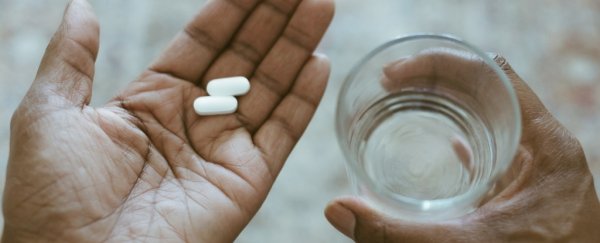Paracetamol, or acetaminophen, is one of the most popular painkillers in the world. Better known by brand names like Tylenol, Panadol or Excedrin, this drug can be used very safely to treat minor aches, pains, and fevers in the short-term.
That said, over the past few decades, unintentional overdoses from paracetamol have been on the rise in many nations, and some scientists think it has to do with the dosages available.
Even when prescribed by physicians, new research from Switzerland suggests a higher dose of paracetamol makes it easier for people to accidentally poison themselves, and while this doesn't often lead to death (we have an effective antidote), it can cause severe liver damage.
In Switzerland, most over-the-counter (OTC) tablets contain roughly 500 milligrams of paracetamol. But in 2003, the nation introduced a prescription-only tablet containing 1,000 mg of the drug.
Within two years, national sales for this larger tablet had outrun the smaller one, and today, the higher dose is sold ten times more.
Analysing calls to the Swiss National Poison Centre before and after 2003, researchers were alarmed to find a significant increase in unintentional overdoses from paracetamol, and most of these cases were tied to the 1,000-mg tablet.
Intentional poisonings, on the other hand, did not appear to increase, which suggests the vast majority of these emergency situations are entirely avoidable.
"One problem with paracetamol is that it is not effective for all patients or against all forms of pain," explains Andrea Burden, a pharmacoepidemiologist at ETH Zurich.
"If the drug doesn't help to ease someone's symptoms, they may be tempted to increase the dosage without consulting a medical professional. That's the real problem."
Many people don't realise that each pill of paracetamol you swallow adds up in the body. This means taking just a few extra 1,000 milligram tablets can put you at risk of an overdose, easily exceeding the 4,000 recommended milligrams a day for adults.
For that very reason, in 2008, the United States Food and Drug Administration (FDA) recommended limiting an adult dose to two tablets containing 325 mg of acetaminophen, with a boxed warning about how toxic byproducts from the drug can build up in your liver, causing damage or even failure.
In Switzerland during these years, however, larger doses were only growing in popularity. Within a year of 1,000-mg tablet being introduced, the new study found a significant increase in acetaminophen-related calls to the Swiss National Poison Centre.
Between 2005 and 2008, there was actually a 40 percent increase in poisoning cases, especially among older adults and kids.
"On that basis, we can conclude that the increased number of poisoning cases is associated with the availability of the 1,000 milligram tablets," says pharmacologist Stefan Weiler, scientific director of the Swiss National Poison Centre.
Interestingly, the results suggest these 1,000-mg tablets are not necessarily replacing 500-mg ones. Instead, it appears an entirely new group of people are being prescribed these larger doses, possibly because they are considered safer pain meds to opioids and other narcotics.
This is worrisome given the limited effectiveness of paracetamol for acute pain and particularly for chronic pain. If people are expecting these meds to work and they're not, they might take another pill too early, putting themselves at risk of overdose.
"We recognize that pain management is challenging, and other medications may have severe adverse effects," says Burden.
"But, if paracetamol doesn't have the desired effect, it's important not to simply take more tablets. Instead, people should seek professional medical advice in order to find the best therapeutic option."
Luckily, 90 percent of people in the study who overdosed on paracetamol received the antidote within 8-10 hours, reducing their risk of liver damage and death.
Yet most of these situations could have been avoided entirely. If paracetamol is not suitable for chronic pain, Burden says, then pack sizes should represent that. They shouldn't contain 40 tablets or more.
"At the very least, packs of the 1,000 milligram tablets should contain a smaller number of tablets," says Burden. Even if a patient needs a higher dose, it might be safer to prescribe two tablets of 500 mg.
While it's too early to determine the exact cause of the poisonings, public health experts have a few ideas. Patients might be mistaking stronger tablets for weaker ones, unknowingly doubling their dose. If this happens in young children, one pill is sometimes enough to put them well above the daily minimum and at risk of poisoning.
Another part of the problem comes from a lack of communication. Many doctors and pharmacists don't take the time to explain to their patients how paracetamol can build up in the body, how it can impact the liver and how the drug is limited when it comes to chronic pain.
These sorts of mistakes are easy to mitigate, we just need to draw attention to the problem.
The study was published in JAMA Network Open.
